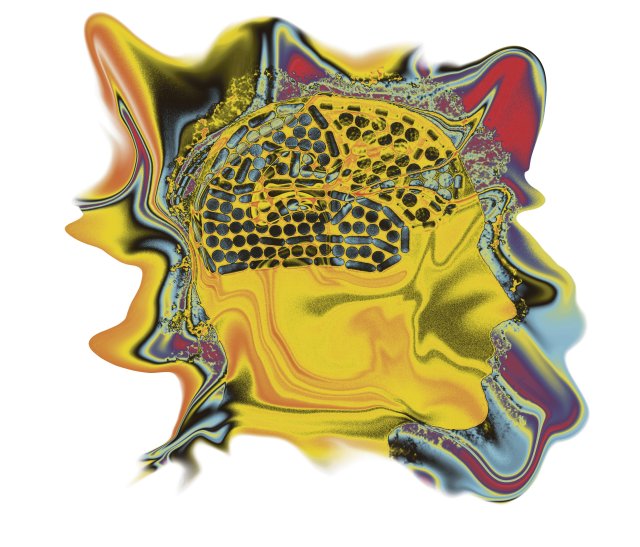A lot happens in the head – which is why addictions cannot only be traced back directly to consumption.
Photo: imago (M)
It was recently reported that drug deaths rose to a record high last year. Does this reflect a social development?
First of all, this makes it clear that we still need to make improvements with regard to low-threshold, harm-reducing offers for consumers. The main cause of drug-related deaths is still heroin, as the figures show. There are also helpful approaches in many places such as consumption rooms or other options to enable consumers to consume with as little harm as possible. Unfortunately, the numbers suggest that we have not yet reached our goal here.
Now there are very different types of drug use. And not all people seem to respond to drugs in the same way. Can you tell when and who a drug becomes addictive?
It is a complex phenomenon. For a long time, research has been carried out into the extent to which self-medication with certain substances appears to be suitable for people who suffer from psychological stress or psychological symptoms in order to make their specific problems more bearable. On the other hand, studies have shown that it is also about availability. This means that there are obviously also external factors that contribute to the direction in which people later end up with their consumption. It’s a mix of personal factors, but also environmental factors.
Interview

CENTER
Professor Dr. with. Ingo Schäfer has been director of the Center for Interdisciplinary Addiction Research at the University of Hamburg since 2017. His work focuses on psychological stress in people with substance disorders and the further development of care offerings in the area of addiction help.
In general terms, what do drugs do in the brain?
All drugs, including nicotine and alcohol, stimulate what is called the endogenous reward system in the brain. This is an evolutionary very old brain structure that actually serves to ensure the survival of the species. This means that the system rewards the search for stimuli, such as food or sexual partners. Various messenger substances play a role, including dopamine. Psychotropic substances that work via the reward system have the ability to increase the release of dopamine there much more efficiently than natural stimuli, which then plays a very important role in the development of manifest addictions.
Does consumption also rebuild the brain in the long term? For example, if you stop smoking, after a short time you no longer feel any physical dependence, but you still feel the urge to smoke.
It is of course the case that craving is also typical in the early phases of abstinence. This effect, this strong connection between consumption and the experience of reward in the brain, persists over a certain period of time and triggers the addictive desire, but weakens. But the so-called addictive memory remains in the long term. This means that when those affected start using again at some point, perhaps after a long period of abstinence, the previous consumption patterns typically appear very quickly again. This is also the reason why it is so important for alcoholic people or smokers, for example, not to consume just a little later.
Many people only use so-called party drugs occasionally when partying. Are they less likely to become addicted?
The phenomenon of dependence is not only linked to the substance, but also to the person, the setting, the environment, the situation and then also the specific substance effects. Party consumers who do not develop addiction are often more integrated people who may have a regular job or study and have a relatively normal everyday context. They then consume in a very specific context against the background of an actually good psychological state and have no problems continuing with this consumption behavior. It is something completely different when a person who does not have such good conditions, is socially disadvantaged, is less well integrated, who struggles with depression, comes across the same substance in a completely different context and develops an addiction. For example, in recent years we have carried out a study on cocaine users and consumption patterns, which clearly shows that there is a large group of integrated users who sometimes use at parties. And then there are other groups in which psychological comorbidities typically also play a role. These groups show completely different consumption patterns.
What role do traumatic experiences in life play in particular in consumption and the development of addiction?
For a large group of people with addiction problems, traumatic experiences are a very important factor when it comes to starting and maintaining consumption. Long-term studies have shown that childhood trauma such as sexual, physical, emotional violence or neglect are among the most robust risk factors for later problematic substance use. We also see this in our work with addicts. For example, this affects at least 50 percent of people with alcohol addiction and an even higher proportion of people who use so-called hard drugs who report such stress from childhood. And here too, the studies show us that there are connections between the experience and its consequences, such as post-traumatic disorders, problems dealing with feelings, certain coping strategies that were acquired or not acquired, and later consumption and also that Success of addiction therapy. This is one of the reasons why we should also take this into account systematically in addiction therapies. This is now happening to some extent, but not yet across the board.
So that means if a person who has corresponding traumatic experiences, If someone is willing to start addiction therapy, would they have to work on these traumas in parallel or even first?
Unfortunately, this view of putting one of the two problems in the foreground initially falls short for many people. It’s definitely about integrating both or treating them in parallel. The first step is to acknowledge that these serious experiences play a role in one’s biography and how they still show up in everyday life today. And then the integration of interventions from trauma therapy into addiction treatment.
In a current project you are working on the prevention and treatment of addiction problems among refugees. What experiences did you have in this work?
On the one hand, a very high proportion of people with a refugee background had to experience severe stress. The reason why they seek protection in Europe is often because they were exposed to war and persecution in their countries of origin. On the other hand, fleeing is associated with stress and, last but not least, there are so-called post-migration stressors: loss of status, loss of resources, accommodation, which can be very stressful, or experiences of discrimination and racism. All of these stressors encourage consumption. We don’t see this in all groups of refugees. There are also protective factors, for example religious beliefs. But we have to make tailor-made offers of help for those who consume them. And that’s exactly where the problem lies. In many ways, people with a refugee background find it much harder to find their way into the help system than people who were born and raised here. And that also applies to the addiction support system. For example, the lack of language training plays a role, or that helpers in the facilities may have some catching up to do in terms of culturally sensitive work. Contacting institutions can also seem threatening to those affected. So there are many factors that we have to adapt to.
Perhaps a first step before offering addiction help would be to provide refugees with humane accommodation.
Absolutely. It also shows, for example, that successful integration, especially among unaccompanied minor refugees who show very high rates of substance use, in many cases means that consumption no longer plays a role at all. So better accommodation, better access to our society, better integration would be the best addiction prevention here.
Drugs can also be used in a positive sense. In psychotherapy there are more approaches to working with psychoactive substances. How should they be evaluated?
This is a very interesting development and it is pleasing that there is a lot of openness about it. There is a lot of research into different substances as supportive aids in psychotherapy. Hallucinogens should be mentioned, but also MDMA, for example, which shows very promising results, especially in the treatment of post-traumatic stress disorder. Ketamine is now used successfully for chronic depression. This opens up a whole spectrum of possibilities, which certainly require more research, but which clearly contain opportunities.
What would have to happen with regard to the approval of these substances for therapy?
They are not yet approved in Germany, with the exception of ketamine. Other countries are already further ahead.
Subscribe to the “nd”

Being left is complicated.
We keep track!
With our digital promotional subscription you can read all issues of »nd« digitally (nd.App or nd.Epaper) for little money at home or on the go.
Subscribe now!
judi bola online judi bola judi bola online sbobet
